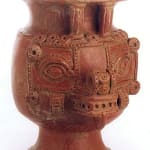Vessel in the Form of the Head of a Saurian Deity, 300 BCE - 500 CE
Terracotta
11.75
PF.4612
This extraordinary and rare vessel was likely made for a shaman as part of his ritual tools. Because the ancient shamans utilized objects in their procedures, the word 'tool' indicates...
This extraordinary and rare vessel was likely made for a shaman as part of his ritual tools. Because the ancient shamans utilized objects in their procedures, the word "tool" indicates such vessels were an essential element in shamanic practice. It may have contained either dry material such as herbs or plants; or more likely therapeutic liquids. The entire design of this vessel is one of perfect balance and harmony, with a variegated surface texture, which contrasts smooth areas with the lovely molding in a very graphic manner. The clay itself sparkles with gold flakes, which may well be real gold, found in the gold-rich mud of Costa Rican streams. The alligator is not only the central figure; it is the vessel itself and constitutes a complete unity of aesthetic beauty and complex ideologies. The Ancient Costa Ricans, (as well as many cultures past and present), believed shamans were capable of changing themselves into animals, particularly the jaguar and alligator. They performed this feat for a number of reasons to commune with animals of the rain forest, to be in contact with spirits, and as a way of being connected with the life force, which exists in all living things. This gorgeous vessel is not only something of beauty, it is a living testimony to a vanished culture which understood aspects of nature and the cosmos long ignored, and yet are still present in this superb work of art.



